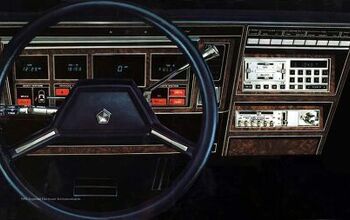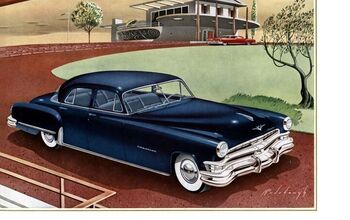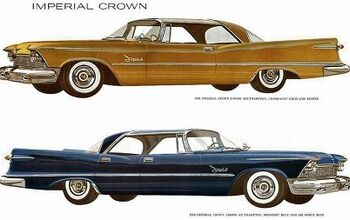Rare Rides Icons: The History of Imperial, More Than Just a Car (Part IX)

Today marks the ninth installment in our history of Imperial, as the calendar flips over to 1961. The second generation Imperial is not quite to the middle of its tenure on its own platform, the D-body. Virgil Exner imposed a wild new styling direction on Imperial for 1960 that was both outlandish visually, and heavy-handed in its execution. “More of that,” said Exner for ’61.
The 1960 Imperial’s front end proved a one-off, as for 1961 the new Series RY1 (with L, M, H trim designations) sported an entirely new visage. Gone was the grinning V-shaped grille and bumper, its wrap-around grille, and half-lidded headlamps. In their place was a front end of a much more horizontal design. The grille was rectangular and constrained between the headlamps. Said headlamps were free-standing, four in number, and rested upon sticks like lollipops. The bumper was much thinner than in 1960, almost completely horizontal, and featured minimal design and adornment. The front fenders were recessed and sculpted behind the lamps, and front-wheel wells implemented a cutaway effect like a car from the Thirties. Script Imperial logos were larger and depicted in an even more dramatic font. Chrome body trim continued all the way to the rear like the prior year but ended in the largest tail fins ever fitted to any Imperial. Tail lamp placement moved to be more inset into the rear fin, and the lighting position was lower. The bumper carried over from 1960, but the trunk’s popular continental kit option gained more detailing and trim. Inside, electroluminescent gauges were no longer in separate circular pods but were grouped together in a horizontal rectangular fashion, just like the car’s new front end design.
Imperial lost a body style this year, as the standard pillared sedan (a basic model) was no more. That left a hardtop and convertible with two doors, and the four-door pillarless Southampton hardtop. The Ghia-built Crown Sedan and Limousine continued with similar changes to production models and were still made as special order vehicles in incredibly small numbers. The new styling in ’61 meant Imperial was slightly longer than before and spanned just over 227 inches overall. Width increased to 81.7 inches, a figure that remained static through 1963. Height remained at 56.7 inches for 1961. The enormous length was notable: In 1961 Elwood Engle at Lincoln restyled the Continental for its fourth generation, and the flagship’s overall length shrunk to 212.4 inches. From 1961 to D-body’s conclusion in 1966, Imperial came with considerable length compared to Lincoln. Imperial was the longest standard (non-limousine) car made in America. The size came at a price: A top trim LeBaron with its crazy styling asked $6,428 ($59,900 adj.).
The awkward styling didn’t go over as well in 1961 as it had in 1960. Sales fell by over 5,000 units to 12,258, a decline of 30 percent. Matters were made worse by a continual decline in overall quality as the D-body aged, a notable issue for discerning luxury customers. Imperial no longer held the prestigious sales crown and handed it over to Lincoln. Chrysler execs ordered up more changes for the 1962 Imperial to try and reverse the company’s fortunes. Production moved back to Jefferson Avenue Assembly where Imperials had traditionally been built, as sales had fallen to a level where it was no longer necessary for Imperial to have its own factory. Illustrious Imperials were built alongside Chryslers once again.
Visuals were more restrained in 1962, as Imperial started to back itself out of the styling corner Exner was so fond of. Given his disagreements with Chrysler’s management, design associates made required edits to the cars after Exner finished them. Known as SY1 (L, M, H), The ’62 model saw only modest changes to its front end as free-standing headlamps remained, but were separated by a new and more pronounced split-wing grille. An upright Eagle hood ornament appeared for the first time, while the bumper below was entirely unchanged from the prior year. Body side trim still ran the full length of the car, but was thinner than before and had less detail. Fenders were clipped of their large fins; only modest ones remained. Like the 1955 and 1956 Imperials, tail lamps were free-standing atop the fenders, and of a gunsight design. Interiors for 1962 remained much the same as the prior year.
There was a change on the mechanical front that year, as the old Torqueflite A466 was replaced by an updated three-speed, the A727. The cast-iron case of the A466 was replaced by a one-piece aluminum case on the A727, which saved on both space and weight. There was a 60-pound difference between the two, and space-saving aluminum meant there was a smaller central transmission hump in the Imperial. That improved the comfort outlook for front middle passengers. For the first time, Imperial had a park button on the gear selector, as A727 had a parking pawl. The A727 gained a reputation for reliability, strength, and ease of repair.
Sales increased slightly with the more restrained look of the 1962 Imperial, up to 14,337. By that time Virgil Exner was headed out the door at Chrysler. He’d had continual disagreements about styling direction with Chrysler’s top brass over the past handful of years, and wanted large fins to continue on cars. Said fins were falling out of fashion by the start of the Sixties, but Exner would hear none of it. He criticized the Dodge and Plymouth designs of 1962, shapes that were downsized by other design associates at Chrysler and had no fins, contrary to Exner’s protests. He declared the Mopars were like “plucked chickens.” 1963 was the last time Exner exerted any influence on Chrysler’s styling, as he’d been fired. Chrysler let Exner stay on as a consulting employee until 1965, where he could retire with his pension at age 55.
Chrysler execs saw the work Elwood Engel did on the 1961 Lincoln Continental and were most impressed. In a timing coincidence, Engel wasn’t thrilled to be at Ford any longer as the company selected Eugene Bordinat to lead Ford’s design department in 1961, instead of Engel. Chrysler hired Engel away immediately as Exner’s replacement, and his design cues started to appear on Imperial for 1963.
The ’63 Imperial was a last-of moment for the D-body, as Exner’s 1961 design received one final showing. The series this year was TY1 (L, M, H). Gone was the split grille of the 1962 model, as it reverted once more to a one-piece horizontal grille, albeit with larger chrome segments than in ’61. Other elements of the front end remained unchanged in the Imperial’s hold-out year. At the rear one of the few changes that year was the tail lamp design, which became much more conservative than before. Set into the rear fenders, the rectangular and upright lamps bore no Mid-century design; they were just lamps. Roof shapes grew more upright this year, as Engel-derived formality took the place of more wacky curved shapes from Exner. Overall length was the only dimension to change in 1963, up slightly to 227.8 inches.
With a new director of design, the Imperial was completely reworked for 1964 as it shored up its final two model years as a D-body. We’ll finish up with this long-lived generation next time.
[Images: Chrysler]

Interested in lots of cars and their various historical contexts. Started writing articles for TTAC in late 2016, when my first posts were QOTDs. From there I started a few new series like Rare Rides, Buy/Drive/Burn, Abandoned History, and most recently Rare Rides Icons. Operating from a home base in Cincinnati, Ohio, a relative auto journalist dead zone. Many of my articles are prompted by something I'll see on social media that sparks my interest and causes me to research. Finding articles and information from the early days of the internet and beyond that covers the little details lost to time: trim packages, color and wheel choices, interior fabrics. Beyond those, I'm fascinated by automotive industry experiments, both failures and successes. Lately I've taken an interest in AI, and generating "what if" type images for car models long dead. Reincarnating a modern Toyota Paseo, Lincoln Mark IX, or Isuzu Trooper through a text prompt is fun. Fun to post them on Twitter too, and watch people overreact. To that end, the social media I use most is Twitter, @CoreyLewis86. I also contribute pieces for Forbes Wheels and Forbes Home.
More by Corey Lewis
Latest Car Reviews
Read moreLatest Product Reviews
Read moreRecent Comments
- Bd2 Lexus is just a higher trim package Toyota. ^^
- Tassos ONLY consider CIvics or Corollas, in their segment. NO DAMNED Hyundais, Kias, Nissans or esp Mitsus. Not even a Pretend-BMW Mazda. They may look cute but they SUCK.I always recommend Corollas to friends of mine who are not auto enthusiasts, even tho I never owed one, and owned a Civic Hatch 5 speed 1992 for 25 years. MANY follow my advice and are VERY happy. ALmost all are women.friends who believe they are auto enthusiasts would not listen to me anyway, and would never buy a Toyota. They are damned fools, on both counts.
- Tassos since Oct 2016 I drive a 2007 E320 Bluetec and since April 2017 also a 2008 E320 Bluetec.Now I am in my summer palace deep in the Eurozone until end October and drive the 2008.Changing the considerable oils (10 quarts synthetic) twice cost me 80 and 70 euros. Same changes in the US on the 2007 cost me $219 at the dealers and $120 at Firestone.Changing the air filter cost 30 Euros, with labor, and there are two such filters (engine and cabin), and changing the fuel filter only 50 euros, while in the US they asked for... $400. You can safely bet I declined and told them what to do with their gold-plated filter. And when I changed it in Europe, I looked at the old one and it was clean as a whistle.A set of Continentals tires, installed etc, 300 EurosI can't remember anything else for the 2008. For the 2007, a brand new set of manual rec'd tires at Discount Tire with free rotations for life used up the $500 allowance the dealer gave me when I bought it (tires only had 5000 miles left on them then)So, as you can see, I spent less than even if I owned a Lexus instead, and probably less than all these poor devils here that brag about their alleged low cost Datsun-Mitsus and Hyundai-Kias.And that's THETRUTHABOUTCARS. My Cars,
- NJRide These are the Q1 Luxury division salesAudi 44,226Acura 30,373BMW 84,475Genesis 14,777Mercedes 66,000Lexus 78,471Infiniti 13,904Volvo 30,000*Tesla (maybe not luxury but relevant): 125,000?Lincoln 24,894Cadillac 35,451So Cadillac is now stuck as a second-tier player with names like Volvo. Even German 3rd wheel Audi is outselling them. Where to gain sales?Surprisingly a decline of Tesla could boost Cadillac EVs. Tesla sort of is now in the old Buick-Mercury upper middle of the market. If lets say the market stays the same, but another 15-20% leave Tesla I could see some going for a Caddy EV or hybrid, but is the division ready to meet them?In terms of the mainstream luxury brands, Lexus is probably a better benchmark than BMW. Lexus is basically doing a modern interpretation of what Cadillac/upscale Olds/Buick used to completely dominate. But Lexus' only downfall is the lack of emotion, something Cadillac at least used to be good at. The Escalade still has far more styling and brand ID than most of Lexus. So match Lexus' quality but out-do them on comfort and styling. Yes a lot of Lexus buyers may be Toyota or import loyal but there are a lot who are former GM buyers who would "come home" for a better product.In fact, that by and large is the Big 3's problem. In the 80s and 90s they would try to win back "import intenders" and this at least slowed the market share erosion. I feel like around 2000 they gave this up and resorted to a ton of gimmicks before the bankruptcies. So they have dropped from 66% to 37% of the market in a quarter century. Sure they have scaled down their presence and for the last 14 years preserved profit. But in the largest, most prosperous market in the world they are not leading. I mean who would think the Koreans could take almost 10% of the market? But they did because they built and structured products people wanted. (I also think the excess reliance on overseas assembly by the Big 3 hurts them vs more import brands building in US). But the domestics should really be at 60% of their home market and the fact that they are not speaks volumes. Cadillac should not be losing 2-1 to Lexus and BMW.
- Tassos Not my favorite Eldorados. Too much cowbell (fins), the gauges look poor for such an expensive car, the interior has too many shiny bits but does not scream "flagship luxury", and the white on red leather or whatever is rather loud for this car, while it might work in a Corvette. But do not despair, a couple more years and the exterior designs (at least) will sober up, the cowbells will be more discreet and the long, low and wide 60s designs are not far away. If only the interiors would be fit for the price point, and especially a few acres of real wood that also looked real.












































Comments
Join the conversation
"...as for 1961...The Ghia-built Crown Sedan and Limousine continued with similar changes to production models and were still made as special order vehicles in incredibly small numbers..." A little vague. Actually, the 1961 Ghia Crown Imperials retained the 1960 exterior styling. There were no 1962 Crown Imperials assembled. Arthur Dailey wrote: "And Virgil Exner was a genius." +1
@Corey--The 55 and 56 had better quality and less extreme styling. I appreciate the Imperials for what they were but that doesn't mean that I want to drive one daily. Thank you again for the great series on Imperials.